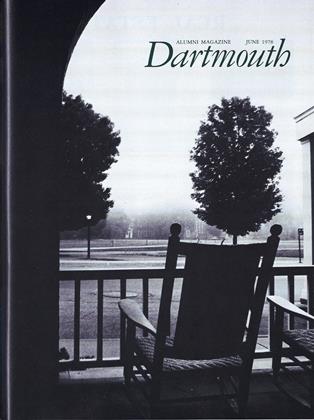Lawrence W. Collins Jr. '32, ed. NonferrousWire Handbook. Vol. 1: Nonferrous WireRod. Wire Association International, 1977. 417 pp. $25. A collection of essays by 22 experts from the industry on the history and technology of wire making. Collins is director of publications of the Wire Association.
Sanborn C. Brown '35. Wines & Beers of OldNew England: A How-to-do-it History. University Press of New England, 1978. 157 pp. Softcover, $5.95; hardcover, $12.95. The author (amateur brewer and emeritus professor of physics at MIT) calls his book "a leisurely recreation of the past." It is all that, and more. If you want to taste what it was like in early New England, you'll find detailed recipes for such colonial alcoholic delectations as birch beer, royal cider, metheglin, applejack, or oak leaf wine. But if you're interested in historical nooks and crannies you'll also discover a thumbnail biography of Squanto, the Patuxet Indian who greeted the Pilgrims in English when they stepped ashore at Plymouth; essays on colonial beekeeping and maple sugaring; and Governor Brad-ford's rueful complaint that in addition to all their other, better known privations he and his Pilgrim band were put ashore berefit of their customary beer and, horrible dictu, "made to drink water that the seamen might have more beer." It's hard to choose between utilitarianism and history; the book is full of both. Either way it's a heady experience. (Excerpted in the October issue.)
Herbert Heaton '40. Productivity in ServiceOrganizations: Organizing for People. McGraw-Hill, 1977. 253 pp. $13.50. His aim, says Heaton, is to explore "the methodology of effective change in achieving two responsible objectives: improving the productivity of organizations serving people and developing people in organizations." His basic premise is that the successful management of organizations producing services requires radically different perceptions, measurements of productivity, and organizational structures than are required in organizations which produce goods. Much of our present discontent with service organizations - government, schools, hospitals, prisons, banks, law firms, foundations, and the like - occurs because we organize them and measure their productivity by standards which do not, and cannot, apply. We must either change our models and measurements or change our world to reflect them, Heaton concludes. "The Established Model can survive alone if we change the world to fit it by burning books, destroying values, and eliminating outside people. By 1984 we can have our Hitler here, our Warsaw ghetto, our Hiroshima." Heaton is comptroller of the Rockefeller Foundation.
Edward Connery Lathem '51, editor. ThirteenColonial Americana. Association of Research Libraries, 1977. 88 pp. $7.50. Designed as a companion volume to 76 United Statesiana, also edited by Lathem and published during the Bicentennial year, this commemorative book gathers significant examples of printing done in each of the 13 colonies in the 50 years preceding the Revolution. Included are such landmark works as Cotton Mather's Christian Loyalty (Massachusetts, 1727) and Tom Paine's Common Sense (Pennsylvania, 1776). New Hampshire is represented by Eleazar Wheelock's Continuation of the Narrative ofthe Indian Charity School (1773). For each of the 13 examples a facsimile title page is provided along with a three-page commentary by a modern librarian-specialist from the state represented. The New Hampshire com- mentary is written by Richard W. Morin, '22, Librarian Emeritus. Designed and printed by Stinehour Press, the book is issued in a limited edition of 1,000 copies.
Lawrence Danson '64. The Harmonies of"The Merchant of Venice." Yale, 1978. 202 pp. $15.00. In this book, which is the more persuasive for being unpolemical, Danson attempts to harmonize two traditional, more or less conflicting readings of The Merchantof Venice, the "ironic" and the "historical." The former, he argues, is too simplistic; the latter leads to "esthetic impoverishment" of the play. Danson's own reading tends to follow traditionally Christian lines: the play "was written by a Christian for a Christian audience, and is about Christian issues"; the central conflict is "not between evil and good but between a Good and a Better." The various strands of the book, much like those in the play it describes, are woven together at the end in a masterful exegesis of the complex ways in which Shakespeare harmonizes the play's thematic antitheses (Jew/Christian, justice/mercy, law/freedom) simultaneously on the dramatic, imagistic, ethical, and metaphysical levels. Danson is associate professor of English at Princeton.
Diana Roebeck Todd '76. Waxing for theComplete Novice. Brandon, Vermont, 1977. 38 pp. $l.00. A paperback manual telling all you could possibly want to know about why, how, when, and with what to wax (and dewax) cross-country skis.
Roger F. Naill, Research Assistant Professor of Engineering, Thayer School. Managing theEnergy Transition: A System DynamicsSearch for Alternatives to Oil and Gas. Cambridge, Mass., Ballinger Publishing Co., 1977. 284 pp. $20.00. On the basis of a mathematical model which posits various interrelationships among the prices of energy, demand for energy, resource capital, availability of labor, possible new technologies, and environmental constraints, Naill first analyzes the degrees to which the United States energy system may be dependent on imported oil in the future as we shift away from our present reliance on fossil fuels, and then evaluates a number of strategies designed to achieve independence from foreign sources of oil. Naill is now on leave, serving as director of the Office of Analytical Sciences, U.S. Department of Energy.
 View Full Issue
View Full Issue
More From This Issue
-
 Feature
FeatureShhh. There still are idealists abroad and they're called the Peace Corps
June 1978 By Dan Nelson -
 Feature
FeatureHonorary Degrees
June 1978 -
 Feature
FeatureThe Valedictories
June 1978 -
 Feature
FeatureFancies, Toyes and Dreames
June 1978 By Mark Hansen -
 Class Notes
Class Notes1974
June 1978 By STEPHEN D. SEVERSON -
 Article
ArticleBad Times to Big Time
June 1978







